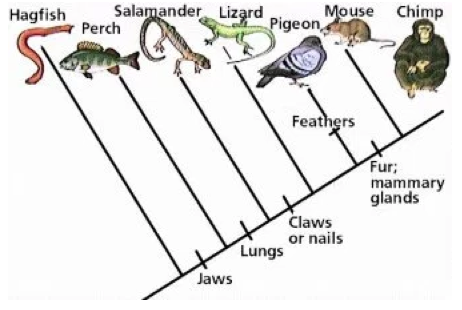Define domestication:
Animals that have been selectively bred and genetically adapted over generations to live alongside humans
Dogs evolved from what wild ancestor?
Wolves
Define taxonomy:
The science of naming organisms.
What is a phylogenetic tree/cladogram?
Graph showing when different groups diverged from a common ancestral line
What is a dichotomous key?
A dichotomous key is a method of identification whereby groups of organisms are divided into two categories repeatedly.
Domestication happens through what process?
Selective Breeding
The African Wild Cat
What is binomial nomenclature?
Describing organisms with two word names
Why is DNA analysis the preferred method for constructing trees?
It is more accurate
When using a dichotomous key to identify organisms, what do we look at?
Physical features
How is taming different from domestication?
An individual wild animal, or wild animal born in captivity, may be tamed—their behavior can be conditioned so they grow accustomed to living alongside humans—but they are not truly domesticated and remain genetically wild
It is estimated that dogs were domesticated when?
11,000 to 33,000 years ago
How are scientific names written?
When we use the binomial name for an organism, we always capitalize the Genus but not the species. We also print the words in italics or underline them.
Example: Canis lupus

The elephant is most closely related to which species?
The kangaroo
A dichotomous key for insects is given. To what order does an insect with two pairs of scaly wings belong?
Lepidoptera
What are the 3 reasons for domestication?
1) domestication for companionship (dogs and cats)
2) animals farmed for food (sheep, cows, pigs, turkeys, etc.)
3) working or draft animals (horses, donkeys, camels)
Through the process of domestication, what unique physical changes did we see in dogs?
-Curled tails
-Mottled (spotted) coats
-Floppy ears
Why is taxonomy useful?
1) Helps prevent confusion among scientists
2) Helps to show how organisms are related
3) Can be used to reconstruct phylogenies – evolutionary histories – of an organism or group

The salamander and lizard share how many traits?
Two
An illustration and a dichotomous key are given. What is the correct classification for this organism?
Order Araneae
What are the 5 traits that make an animal suitable for domestication?
1) They grow and mature quickly, making them efficient to farm
2) They breed easily in captivity and can undergo multiple periods of fertility in a single year
3) They eat plant-based diets, which makes them inexpensive to feed
4) They’re hardy and easily adapt to changing conditions
5) They live in herds or had ancestors that lived in herds, making them easy for humans to control
Why were cats domesticated later than dogs?
Cats were domesticated after people settled down and began farming. The cats fed on mice which gathered near grain storage areas.
What are the 8 levels of classification from most broad to most specific?
Domain (broadest)
Kingdom
Phylum
Class
Order
Family
Genus
Species (most specific)
What do the connection points on the phylogenetic tree/cladogram represent?
A branch point represents the absolute time at which two evolutionary lineages split from a common ancestor.
Based on the dichotomous key, what would the organism labeled "C" be identified as? And why?
Dragon fly because it has wings pointing outwards and wings are not covered by an exoskeleton

